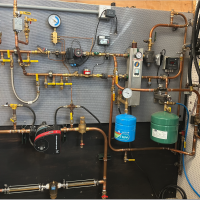Tubing type?
Hello, I'm looking at buying a property that has an older radiant floor heat system. Attached are some pictures of what the tubing looks like. Any idea what this stuff might be? In person, it looks different than some of the old black rubber tubing I've seen used long ago. It is almost like black pex.
Comments
-
Is so hard to tell. Hopefully it's not Lawn Sprinkler tubing. Can you wash it off and read a y numbers? Mad Dog
1 -
Usually there are markings on them tube, printed or stamped. However it may be every 2 feet.
Based on the clamps my guess would be pp, polypropylene. We called it well pipe, as it is commonly used for underground piping from the well to the building. ASTM F2389 is one designation. Also used for lawn sprinklers. There was a company that packaged it with copper tube boilers for carwash snowmelt.
I have never seen any with oxygen barrier, and there are usually lower temperature ratings, different wall thickness and pressure ratings.
It looks like the barb adapters are brass, many were galvanized and would react with the copper manifold, so that is a plus :)
A sample of the water or fluid would tell if it is causing corrosion to ferrous components.
When was it installed? Does it have low temperature protection, a mixing valve to limit excessive temperature?
With proper protection is may work and last for decades.
If you determine it is causing ferrous components to fail, pumps, expansion tanks, steel piping, it could be isolated with a plate heat exchanger, for example.
Bob "hot rod" Rohr
trainer for Caleffi NA
Living the hydronic dream0 -
I did end up trying to clean up some of it but wasn't finding any numbers sadly.
0 -
Thanks @hot_rod I can't imagine using galvanized fittings for any of this stuff. I should take a sample to check for corrosion, great idea!
It seems like it was installed back in the mid 90s. But the person selling the property isn't the original owner, so they don't know for sure. It doesn't look like the current system has a mixing valve at all. Unless it was an older style I didn't recognize.Great advice on using a plate heat exchanger. The system is only for snow melt, so it doesn't have to be ran super hot thankfully.
0
Categories
- All Categories
- 87.2K THE MAIN WALL
- 3.2K A-C, Heat Pumps & Refrigeration
- 60 Biomass
- 427 Carbon Monoxide Awareness
- 119 Chimneys & Flues
- 2.1K Domestic Hot Water
- 5.8K Gas Heating
- 114 Geothermal
- 165 Indoor-Air Quality
- 3.7K Oil Heating
- 75 Pipe Deterioration
- 1K Plumbing
- 6.4K Radiant Heating
- 394 Solar
- 15.6K Strictly Steam
- 3.4K Thermostats and Controls
- 56 Water Quality
- 51 Industry Classes
- 49 Job Opportunities
- 18 Recall Announcements





